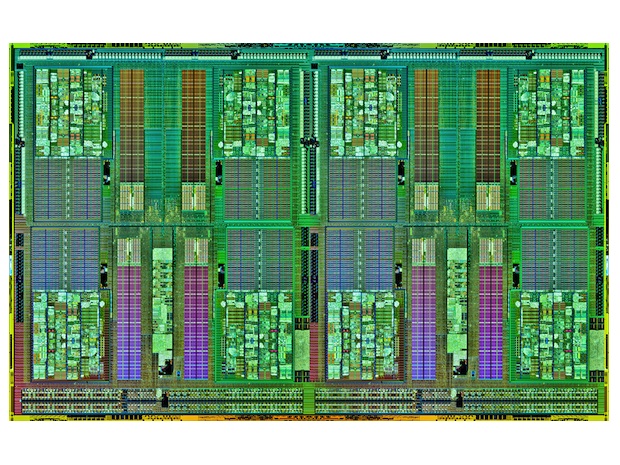AMD's Bulldozer-based 16-core Opterons arrive

AMD has launched two Opteron processors aimed at supercomputers, beating arch-rival Intel to market by several months.

AMD's Opteron 6200, formerly code-named Interlagos, has arrived and will appear in systems from Dell and HP. Photo credit: AMD
The Opteron 6200 and 4200 processor families, formerly code-named Interlagos and Valencia, officially went on sale on Monday. Both chips have been dogged by delays and have arrived around three months later than expected. They are based on AMD's Bulldozer chip architecture and are tailored to systems handling workloads based around virtualisation, high-performance computing and cloud computing.
AMD started shipping the new Opterons to server manufacturers in September. Much of the initial batch went to supercomputer manufacturers such as Cray, with its XK6 system architecture. HP and Dell said on Monday they will launch servers based on the new Opterons, and Oracle and VMware said they are looking forward to putting virtualised workloads on top of the Bulldozer architecture.
"Our industry is at a new juncture; virtualisation has provided a new level of reliable consolidation, and businesses are now looking to the cloud for even more agility and efficiency," Paul Struhsaker, general manager of AMD's commercial business, said in a statement. "We designed the new AMD Opteron processor for this precise moment."
The new Opterons are built to a 32nm process in GlobalFoundries' manufacturing facilities. The Opteron 6200 (Interlagos) is the first mass-market x86 processor to have 16 cores. It will compete with Intel's Xeon E5 processor, which is scheduled to arrive in early 2012. The Xeon E5 will have a maximum of eight cores, though these can behave like 16 cores with Intel's hyper-threading technology.
The Interlagos series of chips should have a thermal design power of between 85W and 140W, with clock speeds topping out at 3.3GHz, though individual speeds can be boosted to 3.6GHz using AMD's Turbo Core technology. Turbo Core allows the performance of individual cores or groups of cores to be temporarily powered up, as long as the chip stays within its overall thermal envelope. The Opteron 4200 (Valencia) chip has Turbo Core as well.
The Opteron 4200 family are low-powerered entry-level versions of the 6200s. Their thermal design power varies between 35W and 95W, putting the chips on a par with Intel's lightweight Xeon E3 processors and Atom chips. Each 4200 chip can have a maximum of eight cores and can be put together in a two-socket system.
AMD's chips lack support for the PCIe 3.0 communications standard, unlike Intel's Xeon E5. Both the 6200 and 4200 Opterons support 1600MHz DDR3 memory, with the 4200 supporting two channels and the 6200, four.
Zurich targetred at microservers
Alongside the launch, AMD announced it is adding an Opteron 3000 family of processors — code-named Zurich — to its 2012 roadmap. The low-power chips are designed to go into lightweight single socket — '1P' — servers and microservers. They will go against Intel's Atoms and 22nm Ivy Bridge-based processors when they arrive.
AMD is billing the chip as an affordable starter chip for basic web hosting tasks. It is based on the AM3+ socket packaging, which makes the processors cheaper, according to the chipmaker.
"This client packaging means significantly lower infrastructure costs for customers. Lower socket prices, fewer layers on the boards, lower overall platform costs," John Fruehe, AMD's evangelist for Opteron processors, wrote in a blog on Monday. "We expect that the 1P market is going to start to heat up over the next few years, so establishing a foothold with the AMD Opteron 3000 Series platform will be important to our long-term business, especially as more customers move to the cloud."
AMD will give more detail on the chips in the future, Fruehe said, and expects to launch them in the first half of 2012.